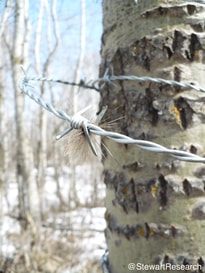MORAINE MESOCARNIVORE PROJECT
Ecology, genetics, behaviour, and species interactions of mesocarnivores in a human-fragmented landscape
Official website link
My PhD research focuses on assessing mammalian connectivity in areas of high human footprint. As human habitation and agriculture continues to expand into areas of prime habitat for biodiversity indicator species such as mesocarnivores (for example: fisher, marten, wolves, coyotes, fox), we not only change the landscape but also consider re-introducing species that may have left because of the change. This generates interesting questions, such as: How will human changes to the landscape influence the biodiversity and functioning of that ecosystem? Why are some re-introductions to altered landscapes successful, and others are not?
Fisher (Pekania [ Martes] pennanti) re-introductions have occurred to try and re-establish their population range to the state it was pre-European settlement, but many of these re-introduction attempts have been unsuccessful. To assess a potentially successful fisher re-introduction to a landscape representative of many economically growing areas of Canada, I am focusing my research on fisher in Alberta’s Cooking Lake Moraine just east of Edmonton.
This project is in close collaboration with Alberta Parks, Alberta Innovates - Technology Futures, the Alberta Wolverine Working Group, the Beaver Hills Initiative, and the Friends of Elk Island National Park.
PUBLICATIONS:
Stewart, F.E.C., J.P. Volpe, and J.T. Fisher. 2019. The debate about bait: a red herring in wildlife research. Journal of Wildlife Management. 10.1002/jwmg.21657. PDF
Burgar, J.M., F.E.C. Stewart, J.P. Volpe, A.C. Burton, and J.T. Fisher. 2018. Estimating density for species conservation: Comparing camera trap spatial count models to genetic spatial capture-recapture models. Global Ecology and Conservation 10.1016/j.gecco.2018.e00411. PDF
Stewart, F.E.C., J.P. Volpe, J.S. Taylor, J. Bowman, P. Thomas, M. Pybus, and J.T. Fisher. 2017. Distinguishing reintroduction from recolonization with genetic testing. Biological Conservation 214:242-249. PDF
Stewart, F.E.C., J.T. Fisher, A.C. Burton, and J.P. Volpe. 2018. Species occurrence data reflect the magnitude of animal movement better than the proximity of animal space use. Ecosphere 10.1002/ecs2.2112 PDF
PRESS RELEASES:
January 2020 - A story of mammals in Alberta's Beaver Hills Biosphere Reserve. Nature Alberta Magazine.
November 2017 - Fishers recolonized remote landscape. The Wildlife Society's eWildlifer.
October 2017 - Fishers in the Biosphere. An article by The Edmonton Area Land Trust.
August 2017 - Finding fishers in the Cooking Lake Moraine. An article from The Nature Conservancy of Canada.
June 2017 - The Alberta Trappers Magazine features The Moraine Mesocarnivore Project!
June 2016 - Dr. Brian Eaton gets interviewed on the Friend's of Elk Island's involvement on the Moraine Mesocarnivore Project. View 'Canada plus grande que nature' video here.
May 2015 - Critter Cameras Revealing Inhabitants east of Edmonton. Featured on Our Edmonton, part of CBC Edmonton.
June 2014 - Elk Island National Park captures elusive black bears. Featured on CBC Edmonton, The Huffinton Post, and the Edmonton Journal.
June 2014 - Examining Beaver Hills Biodiversity. Featured on the Sherwood Park News.
Fisher (Pekania [ Martes] pennanti) re-introductions have occurred to try and re-establish their population range to the state it was pre-European settlement, but many of these re-introduction attempts have been unsuccessful. To assess a potentially successful fisher re-introduction to a landscape representative of many economically growing areas of Canada, I am focusing my research on fisher in Alberta’s Cooking Lake Moraine just east of Edmonton.
This project is in close collaboration with Alberta Parks, Alberta Innovates - Technology Futures, the Alberta Wolverine Working Group, the Beaver Hills Initiative, and the Friends of Elk Island National Park.
PUBLICATIONS:
Stewart, F.E.C., J.P. Volpe, and J.T. Fisher. 2019. The debate about bait: a red herring in wildlife research. Journal of Wildlife Management. 10.1002/jwmg.21657. PDF
Burgar, J.M., F.E.C. Stewart, J.P. Volpe, A.C. Burton, and J.T. Fisher. 2018. Estimating density for species conservation: Comparing camera trap spatial count models to genetic spatial capture-recapture models. Global Ecology and Conservation 10.1016/j.gecco.2018.e00411. PDF
Stewart, F.E.C., J.P. Volpe, J.S. Taylor, J. Bowman, P. Thomas, M. Pybus, and J.T. Fisher. 2017. Distinguishing reintroduction from recolonization with genetic testing. Biological Conservation 214:242-249. PDF
Stewart, F.E.C., J.T. Fisher, A.C. Burton, and J.P. Volpe. 2018. Species occurrence data reflect the magnitude of animal movement better than the proximity of animal space use. Ecosphere 10.1002/ecs2.2112 PDF
PRESS RELEASES:
January 2020 - A story of mammals in Alberta's Beaver Hills Biosphere Reserve. Nature Alberta Magazine.
November 2017 - Fishers recolonized remote landscape. The Wildlife Society's eWildlifer.
October 2017 - Fishers in the Biosphere. An article by The Edmonton Area Land Trust.
August 2017 - Finding fishers in the Cooking Lake Moraine. An article from The Nature Conservancy of Canada.
June 2017 - The Alberta Trappers Magazine features The Moraine Mesocarnivore Project!
June 2016 - Dr. Brian Eaton gets interviewed on the Friend's of Elk Island's involvement on the Moraine Mesocarnivore Project. View 'Canada plus grande que nature' video here.
May 2015 - Critter Cameras Revealing Inhabitants east of Edmonton. Featured on Our Edmonton, part of CBC Edmonton.
June 2014 - Elk Island National Park captures elusive black bears. Featured on CBC Edmonton, The Huffinton Post, and the Edmonton Journal.
June 2014 - Examining Beaver Hills Biodiversity. Featured on the Sherwood Park News.



